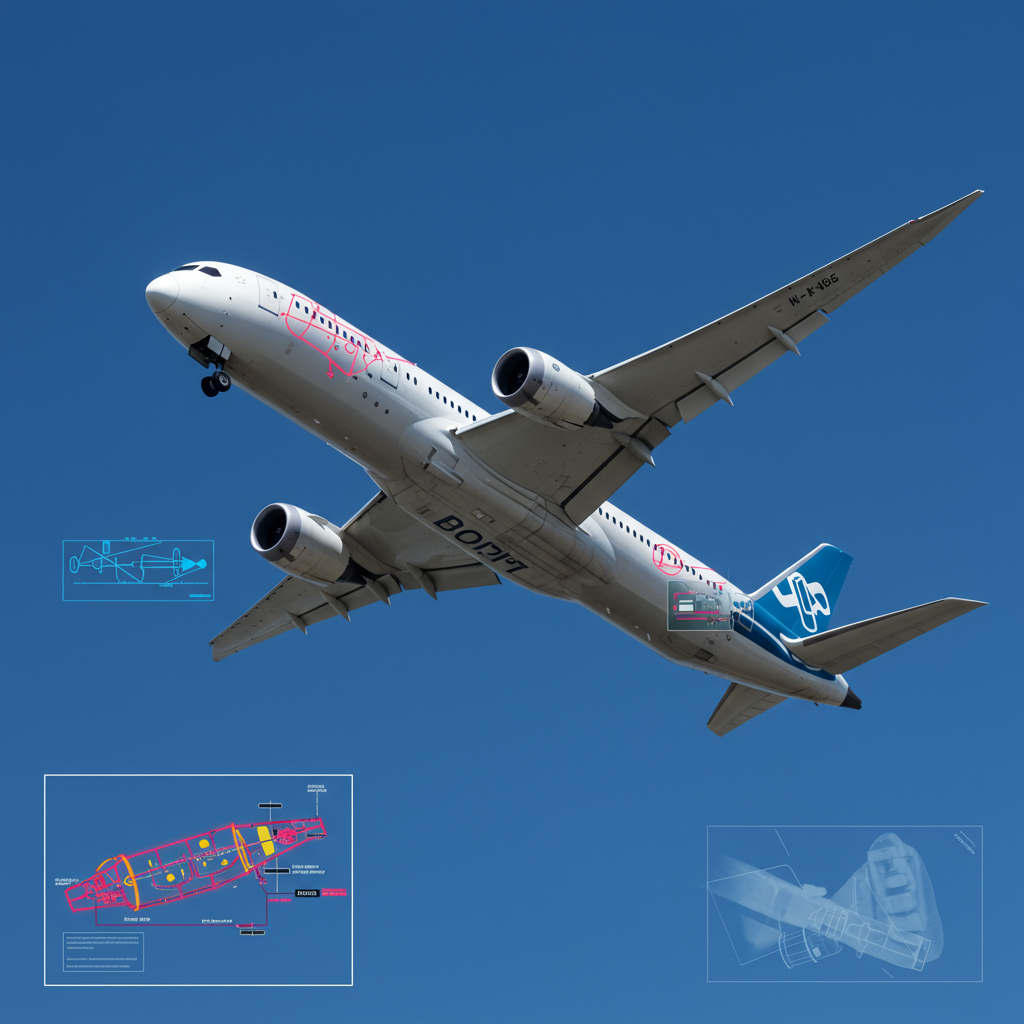The boeing 787 Dreamliner earned a reputation as one of the most advanced and seemingly secure commercial aircraft ever built. For years, this fuel-efficient marvel transported millions globally without a single fatal accident. Yet, behind the scenes, a different narrative unfolded, one echoing with the persistent concerns of individuals who worked directly on the production lines. A recent incident involving an Air India 787 crash, resulting in significant fatalities shortly after takeoff, has sharply refocused public and industry attention on this tension: the Dreamliner’s impressive operational history versus serious allegations of compromised manufacturing standards raised by internal whistleblowers.
Investigators are diligently working to uncover the precise cause of the Air India flight 171 tragedy. Recovering flight recorder data is a critical step in understanding the final moments. However, the incident inevitably shines a spotlight on the aircraft itself, the 787 Dreamliner, a plane celebrated for ushering in a new era of commercial flight.
Prior to this crash, the 787 had flown commercially for nearly fifteen years. It boasted an extraordinary safety record, carrying over a billion passengers across more than 1,100 aircraft in service worldwide. For a considerable time, it stood as a testament to modern aviation’s potential.
The Dreamliner’s Promise: Innovation and Early Success
The journey of the 787 began in the early 2000s. Fuel costs were soaring, a major challenge for airlines globally. Boeing recognized the urgent need for a long-haul aircraft that prioritized efficiency above all else. This strategic pivot marked a departure from their earlier concept, the Sonic Cruiser.
Born from Necessity: Efficiency Over Speed
Initially, Boeing explored building a plane like the Sonic Cruiser. This design aimed for near-supersonic speeds using cutting-edge materials and technology. The focus was strictly on dramatically reducing journey times for up to 250 passengers. However, the landscape shifted dramatically after the events of 9/11. The airline industry faced immense pressure. Carriers communicated a clear message to Boeing: speed was secondary; maximum fuel efficiency for long-range routes was paramount.
A New Era of Aviation: Point-to-Point Travel
Responding to this demand, Boeing abandoned the Sonic Cruiser. They began development on what would become the 787. This strategic shift helped redefine the airline business model. Instead of relying solely on large hub airports and connecting flights, airlines could now use the efficient 787 for direct routes. These point-to-point journeys could link smaller cities, opening up previously uneconomical flight paths. This approach sharply contrasted with Boeing’s main rival, Airbus, which invested heavily in the enormous A380 superjumbo. The A380 was designed specifically for mass transit between the world’s busiest hubs. In hindsight, many analysts view Boeing’s focus on point-to-point efficiency with the 787 as the more prescient strategy, particularly after the fuel-intensive A380 ceased production in 2021. Aviation experts noted Boeing correctly predicted passengers’ preference for direct flights over changing planes at major hubs.
The 787 was genuinely revolutionary in its design. It was the first large commercial jet built primarily from composite materials, such as carbon fiber. This choice significantly reduced the aircraft’s weight compared to traditional aluminum constructions. It incorporated advanced aerodynamic features designed to minimize drag. Furthermore, it utilized highly efficient modern engines from leading manufacturers like General Electric and Rolls Royce. Many conventional mechanical and pneumatic systems were replaced with lighter, more streamlined electrical ones. Boeing projected these innovations would make the 787 approximately 20% more fuel-efficient than its predecessor, the Boeing 767. The aircraft also boasted a significantly smaller noise footprint, reportedly up to 60% less impactful on areas below.
Beneath the Surface: Persistent Production Woes
Despite its innovative design and early operational success, the 787 program encountered significant challenges. Soon after entering service, serious issues emerged. In January 2013, lithium-ion batteries on two separate 787s overheated and caught fire within a week. One incident occurred at a gate in Boston, another forced an emergency landing in Japan. These events led to a worldwide grounding of the 787 fleet for several months. Boeing worked intensely to develop and implement a revised battery system.
Beyond these early operational hurdles, production has been a persistent source of problems. Industry analysts attribute some of these difficulties to Boeing’s strategic decision to establish a new 787 assembly line in North Charleston, South Carolina. This location is over 2,000 miles from their historic manufacturing hub in the Seattle area. This move was reportedly influenced by factors such as lower unionization rates in the region and attractive state incentives.
Geographic Challenges and Assembly Lines
Aviation analysts pointed to “serious development issues” and “notable production issues” directly linked to creating Boeing’s first-ever major production line outside its traditional Puget Sound base. Managing a complex global supply chain and integrating processes across geographically distant sites presented unforeseen difficulties.
Documented Defects and Delivery Disruptions
Starting in 2019, Boeing began identifying a series of manufacturing defects. These problems primarily related to how different large sections of the aircraft fuselage fitted together. As internal investigations widened in response to initial findings, more issues were uncovered. These quality control problems led to severe disruptions in aircraft deliveries. Deliveries were completely halted multiple times between 2021 and 2023 as the company worked to address the manufacturing issues and satisfy regulatory requirements.
Voices of Concern: Whistleblower Allegations
Perhaps the most compelling and concerning scrutiny regarding the 787 program has originated from individuals who worked directly within Boeing’s manufacturing operations – its own employees and former employees turned whistleblowers. Their accounts have painted a troubling picture of pressure to prioritize speed over meticulous quality control.
John Barnett’s Warnings: Scrap Parts and Metal Shavings
Among the most prominent whistleblowers was John Barnett, a former quality control manager at the South Carolina 787 factory. Barnett tragically died by suicide in early 2024 while involved in legal action against Boeing, which he alleged had retaliated against him for raising concerns. In a 2019 interview, Barnett expressed profound fears that pressure to accelerate production compromised safety standards. He claimed workers sometimes failed to properly track components, potentially allowing defective parts to be used. More disturbingly, he alleged that in some instances, substandard parts were deliberately pulled from scrap bins and installed on aircraft simply to avoid slowing down the assembly line. Barnett also highlighted issues with fixings used to secure aircraft decks, claiming they produced sharp metal slivers that accumulated in areas containing critical wiring bundles, posing a potential short-circuit risk.
The US regulator, the Federal Aviation Administration (FAA), investigated Barnett’s claims. While not upholding every single allegation, the FAA investigation partially validated his concerns. The agency confirmed that at least 53 “non-conforming” parts were found to be missing from the factory floor. An FAA audit also corroborated the presence of metal shavings beneath the floors of some aircraft. Boeing stated its internal review board concluded the metal shavings issue did not pose a “safety of flight issue,” although the affected fixings were later redesigned. The company also claimed it had “fully resolved” the FAA’s findings on part traceability and implemented corrective measures. However, Barnett remained deeply concerned about aircraft already in service potentially harboring hidden defects. He stated in 2019, “I believe it’s just a matter of time before something big happens with a 787. I pray that I am wrong.”
Cynthia Kitchens’ Early Concerns
Barnett’s allegations echoed similar claims made years earlier by another former quality manager at the South Carolina plant, Cynthia Kitchens. As far back as 2011, Kitchens reportedly raised concerns with regulators. She alleged that substandard parts were intentionally removed from quarantine bins and used on aircraft to keep the production line moving. Kitchens, who left Boeing in 2016, also claimed employees were instructed to overlook subpar work. She alleged defective wiring bundles, potentially containing internal metal shavings, were knowingly installed, creating a risk of dangerous electrical faults. Boeing has not publicly addressed these specific allegations but stated Kitchens resigned after being placed on a performance improvement plan and that a subsequent lawsuit she filed, which the company characterized as unrelated to quality issues, was dismissed.
Sam Salehpour’s Structural Integrity Claims
More recently, in 2023, a current Boeing employee, quality engineer Sam Salehpour, brought serious concerns before a US Senate committee. Salehpour testified publicly, warning that unaddressed safety problems could lead to “a catastrophic failure of a commercial aeroplane” and mass fatalities. He alleged that while working on the 787 in late 2020, he observed Boeing implementing manufacturing shortcuts aimed at speeding up production and deliveries. Salehpour claimed these shortcuts resulted in “potentially defective parts and defective installations.” His most significant concern related to the fuselage joints where different sections are connected. Salehpour alleged that on the majority of 787s he inspected, small gaps in these crucial joints were not properly rectified during assembly. He warned this could make the joints susceptible to “premature fatigue failure over time,” creating “extremely unsafe conditions” with “potentially catastrophic” consequences. Salehpour suggested that well over 1,000 aircraft, representing most of the global 787 fleet, could be affected by this issue.
Regulatory Response and Company Defenses
Boeing has strongly disputed Salehpour’s most serious claims regarding structural integrity. The company insists that “claims about the structural integrity of the 787 are inaccurate.” Boeing states that the issues raised have been subject to “rigorous examination” under the oversight of the US Federal Aviation Administration (FAA). According to Boeing, this analysis has confirmed the aircraft’s durability and service life over decades, concluding that these issues do not present safety concerns.
It is undeniable that Boeing has faced intense scrutiny in recent years regarding its corporate culture and manufacturing practices. Following two devastating fatal crashes involving its 737 Max aircraft and other subsequent incidents, the company has repeatedly been accused of prioritizing financial goals over passenger safety. Boeing’s leadership, including recent CEO appointments, has publicly committed to overhauling internal processes and enhancing quality control and safety programs in collaboration with regulators.
Weighing the Evidence: Expert Perspectives
Has the 787 fleet been fundamentally compromised by past manufacturing lapses? Expert opinions offer differing perspectives. Richard Aboulafia, a respected aviation analyst, points to the 787’s operational history. He notes its sixteen years in service, over a billion passengers flown, and lack of fatal crashes until now as evidence of a “stellar safety record.” Aboulafia suggests that if major underlying issues existed, they would likely have become apparent over this extensive operational period. He tends to view the production problems as more transient concerns, noting increased regulatory oversight on 787 production in recent years. He believes any serious problems on older planes would have manifested by now. The Air India aircraft involved in the recent crash was reportedly over 11 years old.
However, others express caution. Ed Pierson, who previously served as a Boeing employee and became a whistleblower (unrelated to the 787, initially), now leads the Foundation for Aviation Safety. His organization monitors incident reports and regulatory documents and has been critical of Boeing. Pierson stated his organization had concerns about 787s before the recent crash. He cites examples like FAA airworthiness directives issued last year regarding potential water leaks from washroom taps into electrical equipment bays, prompting mandated inspections, as issues that “make you wonder.”
Ultimately, aviation experts emphasize that the specific cause of the recent Air India tragedy remains unknown. Scott Hamilton, managing director at Leeham Company, an aviation consulting firm, stresses the importance of a rapid, thorough investigation to identify any issues, whether related to the aircraft, the operating airline, or other factors. Despite the questions raised by production issues and whistleblowers, Hamilton notes the 787’s overall safety record remains strong based on operational data prior to the recent crash. He concludes that based on current knowledge of the aircraft, he personally would not hesitate to fly on a 787.
Navigating Uncertainty: The Path Forward
The recent crash serves as a stark reminder that aviation safety is a constant process of vigilance and improvement. While the 787’s innovative design and efficiency have revolutionized air travel, the persistent allegations from whistleblowers and documented production challenges cannot be ignored. The outcome of the Air India crash investigation will be crucial in providing clarity. It will help determine if the crash points to a systemic issue, an isolated event, or factors unrelated to manufacturing quality. For now, the aviation world watches and waits, grappling with the complex legacy of the Dreamliner – a plane of remarkable achievement, shadowed by unsettling questions about its creation.
Frequently Asked Questions
What were the main safety concerns raised by whistleblowers about the Boeing 787?
Whistleblowers alleged significant compromises in manufacturing quality due to pressure for faster production. Specific concerns included claims that defective parts were used, sometimes even taken from scrap bins, to avoid production delays. Allegations also involved manufacturing defects creating hazardous conditions, such as razor-sharp metal slivers accumulating near wiring bundles or improperly fixed gaps in fuselage joints that could lead to long-term structural integrity issues. The FAA partially upheld some claims, confirming missing non-conforming parts and the presence of metal shavings.
Despite concerns, is the Boeing 787 Dreamliner still considered safe to fly?
Experts offer mixed perspectives, though generally lean towards the aircraft’s operational safety based on its history. Before a recent crash incident, the 787 had a record of nearly 15 years and over a billion passengers flown without a fatal accident. While production issues and whistleblower allegations highlight past and potential risks, some analysts argue that any major issues would have likely become apparent over its extensive operational life. Regulatory bodies like the FAA have overseen examinations of the issues raised, and Boeing maintains that these do not present safety concerns for the aircraft’s service life. However, organizations monitoring aviation safety point to ongoing regulatory actions (like directives for inspections) as reasons for continued vigilance.
What production issues have affected the Boeing 787 Dreamliner program?
The 787 program has faced numerous production challenges, partly attributed to setting up a new manufacturing facility far from Boeing’s traditional base. Documented issues include difficulties related to how different aircraft sections fit together, leading to quality control problems identified since 2019. These issues resulted in multiple halts and disruptions to aircraft deliveries. Whistleblowers’ accounts describe specific production shortcuts and the alleged use of substandard parts driven by pressure to maintain production speed. While Boeing states it has addressed specific FAA findings and implemented corrective actions, concerns about the thoroughness and long-term impact of past practices persist among some critics.




